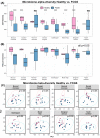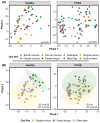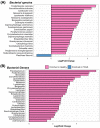The Oral Microbiome across Oral Sites in Cats with Chronic Gingivostomatitis, Periodontal Disease, and Tooth Resorption Compared with Healthy Cats
- PMID: 38003162
- PMCID: PMC10668797
- DOI: 10.3390/ani13223544
The Oral Microbiome across Oral Sites in Cats with Chronic Gingivostomatitis, Periodontal Disease, and Tooth Resorption Compared with Healthy Cats
Abstract
Feline chronic gingivostomatitis (FCGS) is a chronic mucosal and gingival inflammatory disease in which pathogenesis remains unclear. Interactions between the host inflammatory process, the host immune response, and the oral microbiome are implicated in this pathogenesis. To begin to understand this disease and the impact of the microbiome to host inflammatory disease states, we collected sterile noninvasive plaque biofilm samples from ten distinct sites within the oral cavity in cats with stomatitis (n = 12), healthy cats (n = 9), and cats with tooth resorption or periodontitis (n = 11). Analysis of full-length 16S rRNA gene sequences indicated that the microbiomes of cats with FCGS presented marked dysbiosis at multiple oral sites. Additionally, microbiome beta diversity varied with oral condition, indicating that stomatitis, periodontitis, and/or tooth resorption influence the microbiome differently. Lastly, we found that the microbiomes of swabs taken from the oral cavity were comparable to those taken from plaque using endodontic paper points, validating this as another sampling method. Collectively, our work furthers our understanding of the dysbiosis and composition of bacteria in the oral microbiome in FCGS, with hopes of contributing to the prevention, diagnosis, and treatment of this challenging condition in felines.
Keywords: cats; dysbiosis; gingivostomatitis; oral microbiome; periodontal disease; stomatitis; tooth resorption.
Conflict of interest statement
The authors declare that this study was funded in part by AnimalBiome, a company that provides microbiome testing services and products for companion animals. C.A.R., E.S., Z.E., G.J. and H.H.G. are employees of AnimalBiome and have stock options in the company.
Figures






Similar articles
-
Case Report: Shift from Aggressive Periodontitis to Feline Chronic Gingivostomatitis Is Linked to Increased Microbial Diversity.Pathogens. 2025 Feb 26;14(3):228. doi: 10.3390/pathogens14030228. Pathogens. 2025. PMID: 40137713 Free PMC article.
-
Presence and quantification of mast cells in the gingiva of cats with tooth resorption, periodontitis and chronic stomatitis.Arch Oral Biol. 2010 Feb;55(2):148-54. doi: 10.1016/j.archoralbio.2009.11.004. Epub 2009 Dec 16. Arch Oral Biol. 2010. PMID: 20018273
-
Characterization of Oral Microbiota in Cats: Novel Insights on the Potential Role of Fungi in Feline Chronic Gingivostomatitis.Pathogens. 2021 Jul 17;10(7):904. doi: 10.3390/pathogens10070904. Pathogens. 2021. PMID: 34358054 Free PMC article.
-
Stromal cell therapy in cats with feline chronic gingivostomatitis: current perspectives and future direction.J Feline Med Surg. 2023 Aug;25(8):1098612X231185395. doi: 10.1177/1098612X231185395. J Feline Med Surg. 2023. PMID: 37548494 Free PMC article. Review.
-
Impact of Oral Microbiome in Periodontal Health and Periodontitis: A Critical Review on Prevention and Treatment.Int J Mol Sci. 2022 May 5;23(9):5142. doi: 10.3390/ijms23095142. Int J Mol Sci. 2022. PMID: 35563531 Free PMC article. Review.
Cited by
-
Feline Chronic Gingivostomatitis Diagnosis and Treatment through Transcriptomic Insights.Pathogens. 2024 Feb 21;13(3):192. doi: 10.3390/pathogens13030192. Pathogens. 2024. PMID: 38535535 Free PMC article.
-
Probiotics and Cat Health: A Review of Progress and Prospects.Microorganisms. 2024 May 27;12(6):1080. doi: 10.3390/microorganisms12061080. Microorganisms. 2024. PMID: 38930462 Free PMC article. Review.
-
Recovery of Vandammella animalimorsus from an immunocompetent female patient following cat bite to the lower leg.Future Microbiol. 2024 Aug 12;19(12):1049-1054. doi: 10.1080/17460913.2024.2357966. Epub 2024 Jul 17. Future Microbiol. 2024. PMID: 39016073 Free PMC article.
-
Microbial Interconnections in One Health: A Critical Nexus Between Companion Animals and Human Microbiomes.Microorganisms. 2025 Jul 3;13(7):1564. doi: 10.3390/microorganisms13071564. Microorganisms. 2025. PMID: 40732073 Free PMC article. Review.
-
Co-occurrence of feline chronic gingivostomatitis and oral squamous cell carcinoma in 4 cats (2014-2024).Front Vet Sci. 2025 Apr 29;12:1564674. doi: 10.3389/fvets.2025.1564674. eCollection 2025. Front Vet Sci. 2025. PMID: 40365130 Free PMC article.
References
-
- Bellows J. Feline Oropharyngeal Inflammation. NAVC Clin. Brief. 2010:33–37.
LinkOut - more resources
Full Text Sources
Miscellaneous

